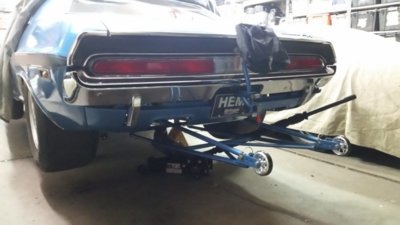---
So here's what I know after lots of measurements. On my car. Calvert Split Monos, Cal Tracs, Dana and QA1 dble shocks:
Front of Dana behind yoke raised until tires start to unload: 1.5 change. 2.0 degrees Neg PA
At stock ride height, which is 21" distance from wheel lip to ground: 3.5 degrees Neg PA
Car raised 1 inch, 22" distance from wheel lip to ground: 2.5 degrees Neg PA
Car raised 2 inches, 23" distance from wheel lip to ground: 2.0 degrees Neg PA
Car raised 3 inches, 24" distance from wheel lip to ground: 1.0 degree Neg PA
Car raised 4 inches, 25" distance from wheel lip to ground: .5 degree Neg PA
* At 4 inch of raise the rear tires had lost almost all contact with the ground.
This exercise sure told me a lot about pinion angle change. From watching vids it looks like I'm getting about 2" of raise at max on my car. That tells me my car should be running about 2 degrees neg pinion angle during a pass. While there was pinion angle change it wasn't too surprising. Has anyone checked their cars to see what there PA is doing? I'd imagine it should be similar with the same components.


















